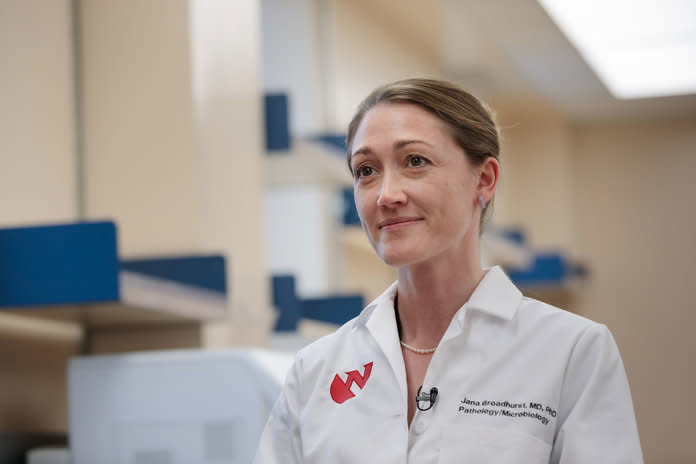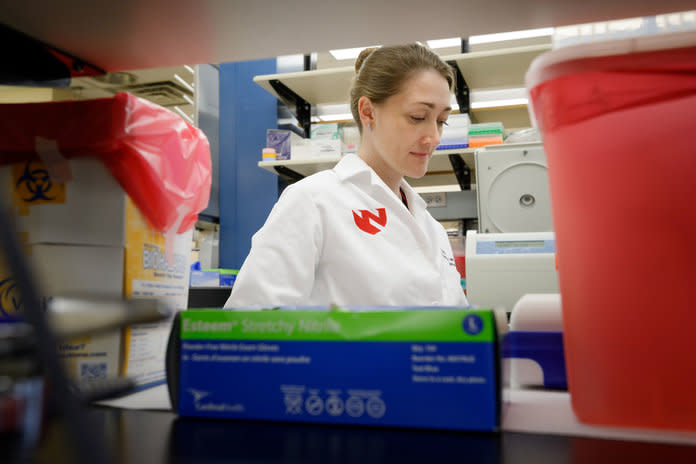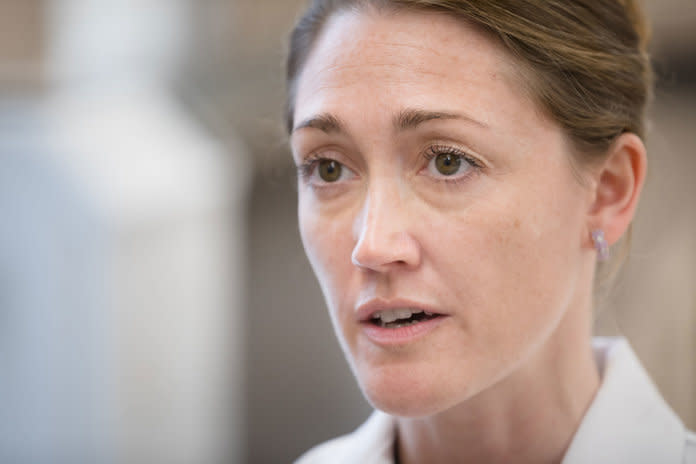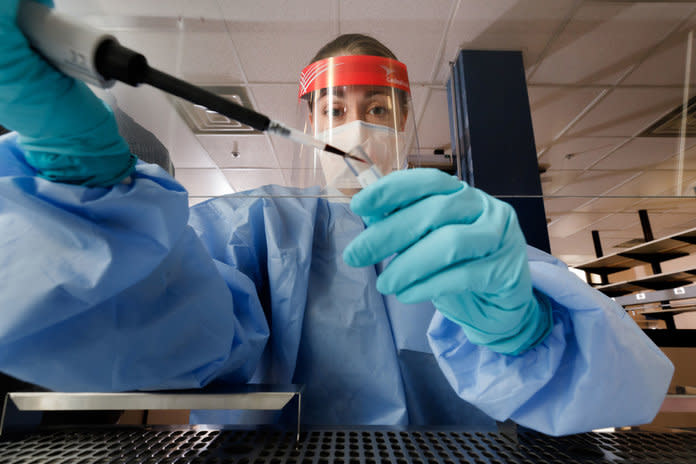What It’s Like to Be a Scientist on the Front Lines of the Coronavirus Pandemic
Dr. M. Jana Broadhurst has been on the coronavirus front lines working about 20-hour days since mid-January, but this is not her first time dealing with a threatening virus. The medical director of the Nebraska Biocontainment Unit Clinical Laboratory — the largest of its kind in the United States — also closely studied the Ebola virus outbreak in 2014. When the coronavirus hit, the 37-year-old pathologist and microbiologist, along with her team, was among the first in the country to develop a faster, more efficient diagnostic test than the one originally provided by the Centers for Disease Control and Prevention. Now, as COVID-19 continues to spread rapidly, Dr. Broadhurst is learning more about the coronavirus in real time.
SP: Your coronavirus test can produce results in four to six hours instead of several days. Can you talk about that?
JB: Absolutely. The gold standard for testing for the coronavirus is what’s called a PCR test, which takes a few hours from start to finish. It also requires getting specimens to the lab and processing them before the PCR test can be performed. The advantage we had early on in our lab was our ability to develop a PCR test in-house and to perform that test on-site.

Dr. M. Jana Broadhurst at the University of Nebraska Medical Center on March 25. Photographed by Kent Sievers.
SP: As this virus spreads, why is it important to continue focusing on advancing diagnostic tests as opposed to, say, vaccines or forms of treatment?
JB: Diagnostics, therapeutics, and vaccines are all critical pillars for an outbreak response. All those efforts need to work together. Diagnostic testing will maintain an important role throughout the duration of this response. We’ll use it to understand where the outbreak is going and which communities are affected. It will also help to guide the management of patients.
RELATED: How Your Favorite Fashion Brands Are Helping Out During the Coronavirus Pandemic
SP: How long will the coronavirus affect our daily lives?
JB: The coronavirus will be affecting us for months. And the need for tests will evolve over that time. Right now, most of our testing is performed in large laboratories. But we will need to distribute [testing kits] to communities and clinics to get more rapid results and to effectively manage the response on a local level. As we move forward, we’ll also need to understand who may have developed immunity to the virus. That will help to [determine], for example, the role of healthcare workers and when people will be ready to be back in the community.
SP: What is the mentality in the lab right now? Is there a sense of fear or urgency?
JB: I would say the mentality is one of commitment. There is a sense of urgency as we’re called upon to release results faster and faster. But what’s most important is that we have reliable and accurate results. That’s what we’re all about. We may work long hours, but we work systematically so we don’t miss anything.

Dr. M. Jana Broadhurst at the University of Nebraska Medical Center on March 25. Photographed by Kent Sievers.
SP: What scares you the most right now?
JB: [I’m most concerned] about the ability to cope socially with the isolation measures that have been necessary. And what’s also frightening is the inability to project what the challenges are going to be week by week. We all have to be adaptable and take the challenges as they come.
SP: And what gives you hope?
JB: There’re a lot of things giving me hope! I am really encouraged by the willingness of our healthcare workers to rise up and adapt to the challenges they face. I’m also encouraged by the community. I look around and see how coffee shops, restaurants, supermarkets, etc. are adapting. I think everyone is doing their best to do what is right, to take responsibility for curbing transmission.
SP: You have experience studying other outbreaks, like the 2014 Ebola virus epidemic in West Africa. What makes this particular coronavirus stand out compared to others?
JB: This coronavirus is very easily transmitted through contact that people have in their everyday interactions. [What sets it apart] is how rapidly and how extensively it’s been able to spread from person to person. And although the severity of the disease is less than, say, the Ebola virus, its ability to infect people is much greater.
SP: How are you coping with this prolonged stress? I’ve read that you brought a guitar to your office…
JB: That is true. Music is a crutch for me — it has been my whole life. I also call upon family and friends for support. And I rely on the companionship of my colleagues here who are all working so hard every day.

Dr. M. Jana Broadhurst at the University of Nebraska Medical Center on March 25. Photographed by Kent Sievers.
SP: What is your biggest challenge going forward?
JB: The challenge is the sustainability of this work, which is really dependent on the supply chain, including [access to] the materials we need to collect specimens, to process those specimens in the laboratory, and to get these results out. That’s a national challenge that we’re all working on.
SP: What is your take on how this is being handled by both federal and local governments?
JB: As a medical center, we work very closely with our local leadership. The medical center and our public health laboratory work side-by-side to address these challenges for our community and for our state. That’s been a very productive relationship throughout this process.
SP: What is your best advice for everyone as we deal with this pandemic? What can we do to help?
JB: We all need to stay informed and follow the guidelines of our local public health authorities. Each community, each state is at a different phase of being affected by this coronavirus.
SP: What do you think will be this pandemic’s lasting effects on the world?
JB: I think there are going to be some very important improvements in our ability to respond to an outbreak, in particular to the outbreak of a novel pathogen. We have to come together and understand what our current limitations are across our healthcare system. We have to have all the systems in place to sustain and expand that testing on a scope that our healthcare system has never really had to deal with in modern times.
SP: Where does your passion for this kind of scientific work come from?
JB: During my early years in science, when I was at the University of California, San Francisco, I studied neglected tropical diseases, parasitic diseases for which there are very few, if any, diagnostic tests available. I learned that our ability to help individuals and develop public health policy around diseases was limited by our ability to detect them. During the Ebola outbreak in West Africa, it became clear that the capability to develop these tools rapidly and respond in real time to public-health threats played a central role.

Dr. M. Jana Broadhurst at the University of Nebraska Medical Center on March 25. Photographed by Kent Sievers.
SP: And how has your family reacted, especially right now as you put yourself on the front lines of the coronavirus outbreak? Are they scared for you?
JB: My family knows this is my passion. This is what I live for. I think they’re happy that I’m in a place where I can apply my passion and have an impact. They do worry. But I think they know that I’m actually in the safest place that I possibly can be considering the team and level of expertise we have here.
SP: How do you think this pandemic will change the way the world looks at scientists in the future?
JB: More than any other event in recent memory, this event will drive home the immediate impact of science and research on our daily lives. I’ll also say there’s been an opportunity for investments to be made through channels like social media [which allow for a new] kind of visibility [of needs]. That says to me that the community is paying attention and understands the value of science. Science doesn’t happen in a separate lane from the rest of our daily lives.
SP: At InStyle we celebrate scientists, astronauts, and other badass women who lead the way by showing up, speaking up, and getting things done. What would you say makes a badass woman in your field?
JB: The willingness to step outside your comfort zone and do what you know is right even if you don’t have a rule book to follow. [I’ve learned that] you can apply your education, your training, and your experiences to really be a leader. And that means extending beyond your daily routine and making hard decisions to move the field forward.
SP: What have you learned about yourself as a leader?
JB: I lead by being a part of the team. I think that being in the trenches and working side-by-side through the long hours and the hard tasks is what keeps us motivated. We’re all in it together. And we’re willing to keep our sleeves rolled up and do the work.
The coronavirus pandemic is unfolding in real time, and guidelines change by the minute. We promise to give you the latest information at time of publishing, but please refer to the CDC and WHO for updates.

